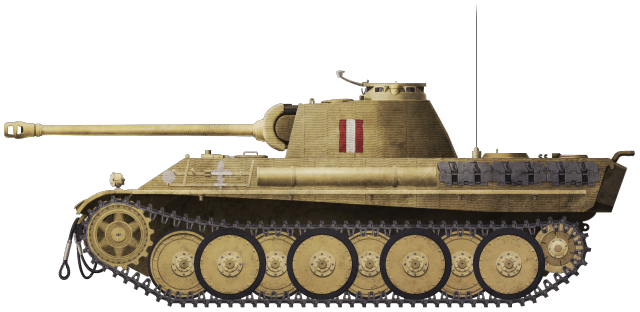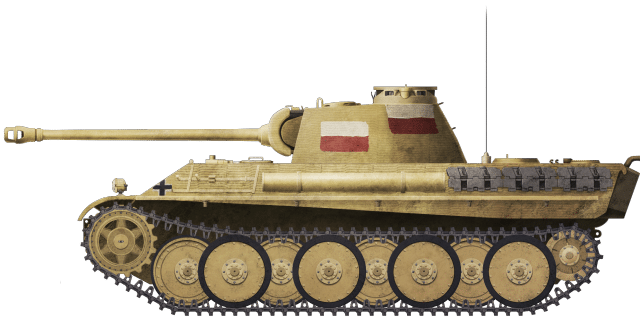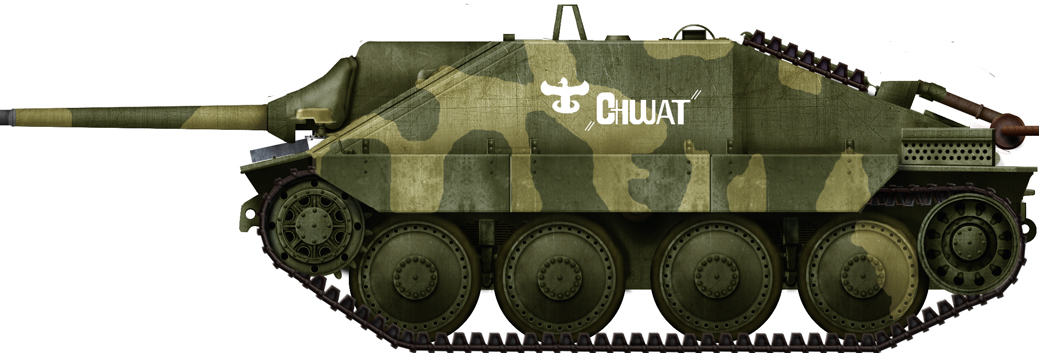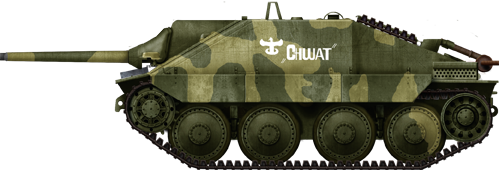 Polish Underground State (1944)
Polish Underground State (1944)
Tank – 1 Captured
Tanks during Warsaw Uprising
After the invasions of September 1939, Poland was occupied and split between Germany and the Soviet Union. However, the occupation did not stop the Polish people from continuing to resist. Soon after the occupation, the Home Army (Polish: Armia Krajowa) was established, an underground resistance group.
Their most notable action would be during the Warsaw Uprising, which started on August 1st 1944 at 5 PM. The organizers of the Uprising hoped that the Soviets, who were near Warsaw, would help them, but the Red Army stopped just 10 km from the city. The first days of the Uprising went well for the Home Army, thanks, in part, to the capture of German vehicles, including two Panthers and a Jagdpanzer 38(t).
The Uprising tragically ended on October 2nd, 1944, leaving tens of thousands of civilians and thousands of troops on both sides dead. The city was razed to the ground by the Germans as a way to punish the Poles who had rebelled against them. The city would be rebuilt after the War by a new pro-Soviet Communist government.

In contrast to the insurgents, the occupying German soldiers were well equipped. German tanks, although not designed for urban combat, were powerful and terrifying weapons that were able not only to crush the insurgent’s barricades but also weaken morale by their mere presence on the battlefield. The anti-tank weapons available to the insurgents were scarce, although they did use grenades and Molotov cocktails in their attempt to destroy the enemy’s tanks.
For the Polish forces of the Uprising, the most treasured vehicles were full-armored troop carriers, such as the famous “Kubuś” armored car or captured German Sd.Kfz.251 half-tracks. One of these captured half-tracks, later known as “Szary Wilk” (eng. Gray Wolf) was additionally armored. At this time, even the German Army had no heavy vehicle specialized for urban warfare, as even the Sturmtiger, two of which were used against the Insurgents, was only in its troop trials phase as a vehicle.
The Panzerkampfwagen VI Tiger, built in August 1942, is one of the most famous tanks in the world. Its powerful 88 mm KwK 36 L/56 cannon and strong armor had allowed Tiger to dominate the battlefield and overwhelm Allied tanks until late in the war. The participation of Tigers in the Warsaw Uprising is disputed.

Some Polish sources mention that the Germans used about 5 to 11 Tiger I’s, but other sources deny the use of Tiger I’s in the Warsaw Uprising altogether. It seems that the Tiger I would have been of little use in the built-up areas, as these slow and massive juggernauts were designed mainly for longer-range engagements. What is more, Tiger I losses during the Uprising are also disputed, with some sources mentioning a few destroyed tanks, while other sources claim that no Tiger I was destroyed and some were merely damaged and fixed soon after.
This confusing set of Polish sources is contradicted by the diaries of Tiger units, none of them were involved in the fight against the Insurgents. Heavy Panzer Battalions in Eastern front (509th, 507th, 505th, 501st, 502nd) were fighting in different locations during the Uprising, so it is almost assured that the only Tigers that participated in the Warsaw Uprising were two Sturmtigers.
Some Polish sources even mention that one Tiger I was captured although it does not claim it saw combat. This particular version of the story of this captured “Tiger” tank is peculiar and contradictory, which raises questions about whether the insurgents really captured such a heavy tank or they mistook another vehicle for a Tiger.
The Insurgent Tiger of Ochota District
The capture
On August 4th (3 days after the Uprising began), a German convoy composed of two tanks and a few armored cars and half-tracks was moving eastwards from the area of Narutowicz Square toward Okęcie. Insurgents attacked the convoy and succeeded in isolating the two tanks from the rest of the vehicles in the convoy. These tanks turned onto Barska Street and then onto Kaliska Street. The insurgents were already waiting for them equipped with Panzerfausts that had been seized a few days earlier during an engagement with the Germans in the school near Radomska Street. One of the ambushers, Sergeant Jan Ostrowski “Osa” (“eng. Wasp”), was hiding behind the fence of 9 Kaliska Street and attacked the first tank with his Panzerfaust.

The rocket missed its target and instead struck a telephone pole, or, according to other sources, a street lamp which fell on the advancing tank. The crew of the German tank panicked and attempted to evacuate to the second tank, but only one man of the crew would manage this, with the others being killed by the insurgents’ fire. The second tank retreated to Narutowicz Square, allegedly being damaged. This is the vehicle identified in the story as a Tiger and it is this abandoned vehicle that was seized by the Insurgents.
Examination of the new weapon
In the captured tank, the insurgents found a few thousand rounds of 7.92 mm ammo, three machine pistols, 25 grenades, and a number of shells claimed to be of 8.8 cm caliber. As the tank itself was a rare and valuable prize, the insurgents planned to use it against the Germans. Lieutenant Jerzy Kołodziejski “Nieczuja” started the ‘Tiger’ and drove it into the safe area of Barska Street. The insurgents also chose the crew for the captured tank – the only known one is senior ogniomistrz (firemaster) Stefan Czapiński/Czapliński “Bór” (“Thicket”), who took up the position of gunner.
The insurgents, excited by their capture of an intact tank, planned to use it to break out from Ochota to the Śródmieście district, where other units were fighting. They also planned to use it to recapture the Warsaw University of Technology which had been captured by the Germans. However, their plans were shattered by the tomfoolery of one young man.
A powerful tank vs. one overly enthusiastic boy
Unfortunately, during dinner time, a young guard (who apparently was not even a fighting insurgent, just a Polish scout) climbed into the tank and started it in an attempt to drive the vehicle. According to other sources, one young insurgent was playing with the tank’s cannon, accidentally firing it, as a result destroying several captured cars. During this short ride, the unlucky ‘driver’ damaged the tank’s controls, which disabled the whole vehicle.
As a result, the tank was abandoned after dismounting all the machine guns and ammunition (propellant from the cannon’s shells was still useful for grenades). The alleged ‘Tiger’ was eventually blown up by the Germans on August 9th. To do this, the Germans used a self-propelled Sd.Kfz.302 (or 303) Goliath remote-control mine, but the Insurgents managed to cut the control cable of the first Goliath. The second Goliath fulfilled the task and blew the tank up – as well as a big part of a nearby home.

The doubts: was it a Tiger?
Even without the contradictions mentioned above, some details make the whole story about the Pz.Kpfw.VI Tiger captured by Warsaw Insurgents doubtful:
Sources generally deny a Tiger’s usefulness in urban counter-insurgency operations. Also, no Heavy Tank Battalions were engaged in the Warsaw region.
Barska Street was very narrow and it would be dangerous and difficult for such a heavy tank to drive through. One of the most questionable points of the story is that the collision with a wooden telephone pole made a skilled German tank crew to abandon their tank and run through enemy fire.
The Panzer VI Tiger was a very advanced and complex tank, with a crew of 5 men. The story states that one young untrained insurgent managed to not only start the engine, but also drive the tank and even fire the heavy 88 mm cannon. This is probably too much of a stretch to believe.
Some insurgents mention that this tank was indeed a Panzer V Panther but these look nothing like the much more ‘square’ Tiger. Panthers were, however, used by the Germans against the Warsaw Insurgents. Also, the insurgents captured and used two of these tanks in another part of Warsaw, so the capture of a third one is plausible.
Conclusion
The story of the captured and, unfortunately for the insurgents, unused tank is presented in a lot of sources, but the exact type of tank is questionable at best. Warsaw Insurgents – as many WWII soldiers on the Eastern and Western European fronts – used ‘Tiger’ many different types of German tanks. Due to its powerful armor and armament (but also thanks to the Nazi propaganda), the Panzer VI Tiger was very famous in its time – as it is famous today.

It is possible therefore that this captured tank was not a famous ‘Tiger’, but something more commonly encountered, such as a Panzerkampfwagen IV or a Panther. On the day of the mentioned tank capture, a convoy of such tanks was traveling through the Ochota District and fought against the Insurgents. Also, the additional ‘Schürzen’ armor made the Panzer IV look similar to the Tiger to the untrained eye, increasing its apparent size. The Warsaw Insurgents may just have mistaken the famous tank with an upgraded Panzerkampfwagen IV. With no photographs to support the ‘Tiger’ claim and with no records of any Tiger-equipped units in the vicinity it is highly unlikely that the tank captured on Barska Street was a Tiger. The capture of a tank is not disputed but what tank it was may never be known.
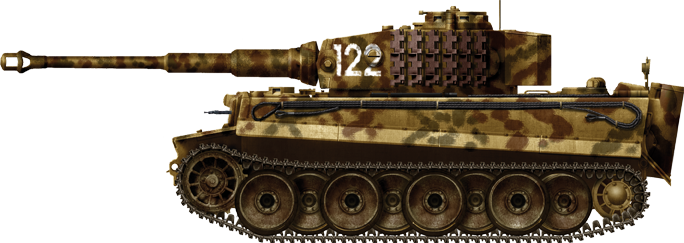
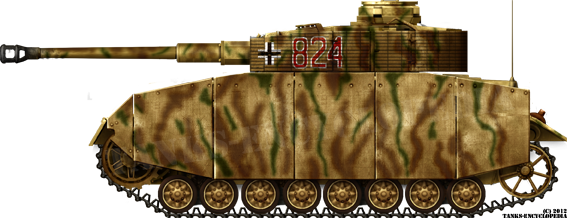
Sources
http://odkrywca.pl/pokaz_watek.php?id=66576
http://www.sppw1944.org/index.html?http://www.sppw1944.org/powstanie/czolgi.html
http://www.historycy.org/index.php?showtopic=15499
https://www.dws.org.pl/viewtopic.php?f=20&t=7373
https://www.1944.pl/artykul/goliath-w-muzeum.,3612.html
Wozy Bojowe Świata magazine, nr. 2/2018, Numer Specjalny: Broń pancerna w Powstaniu Warszawskim
“Czołgi Wojska Polskiego 1939-1945 vol.II” by Janusz Ledwoch (Wydawnictwo Militaria, Warsaw, 2017)
Standard Catalogue of German Military Vehicles, by David Doyle, copyright for the Polish edition, 2012, Vesper, Poznań
Tracked Hussars Shirt
Charge with this awesome Polish Hussars shirt. A portion of the proceeds from this purchase will support Tank Encyclopedia, a military history research project.









